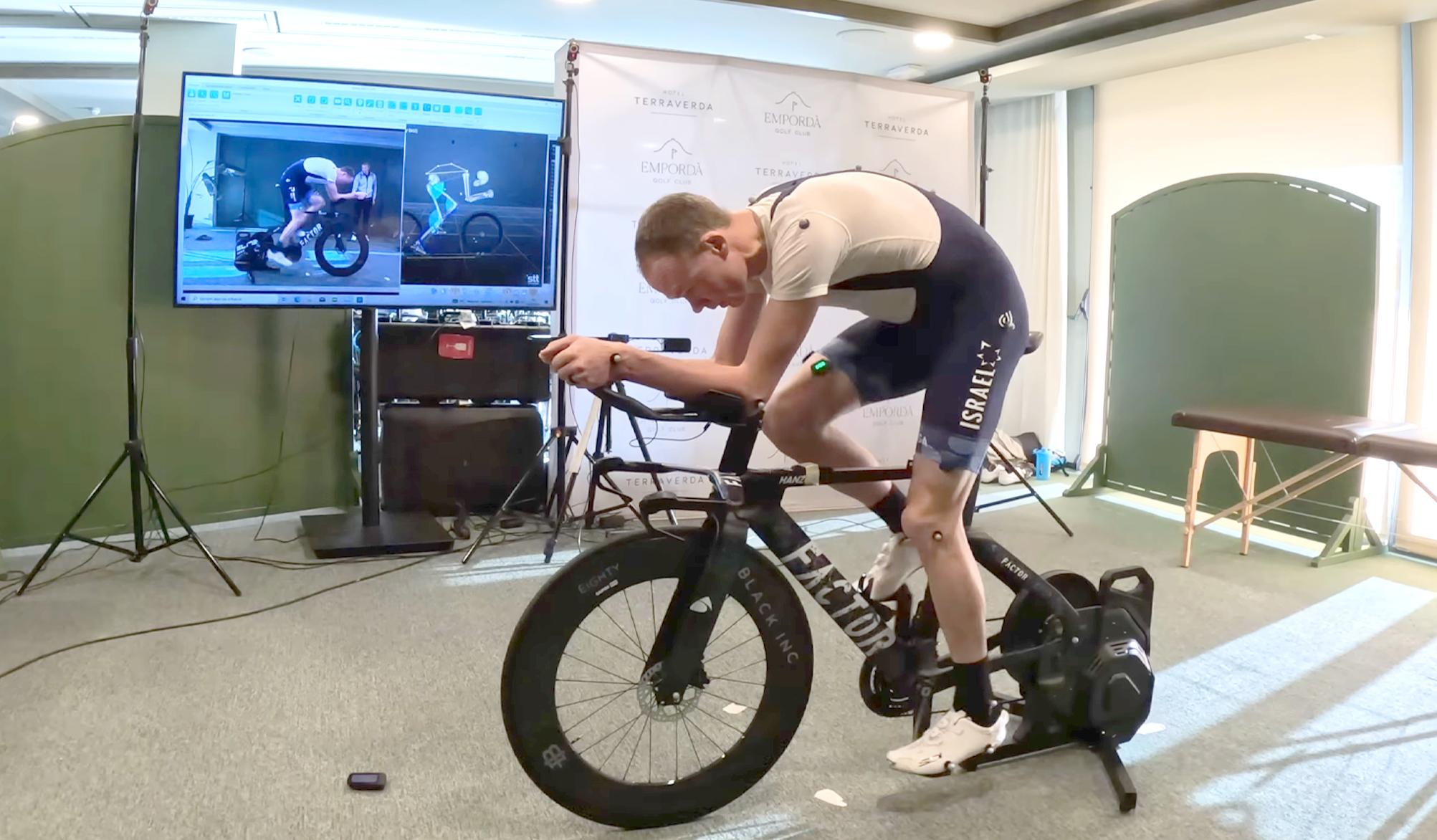Biomechanical analysis in cycling with Cycling 3DMA: Improving the position of Chris Froome
Summary
At the training camp of the professional cycling team “Israel – Premier Tech Pro Cycling Team”, podiatrist and bike fitter Gerardo Lozano used Cycling 3DMA to analyze Chris Froome’s kinematic and kinetic data and improve his position on the bike.
Froome, in a video on his YouTube channel, explained that they were doing a TT bike fit and reviewing the new UCI regulations. After analysis, it was decided to raise the handlebars a bit and lower the saddle to flatten Froome’s position, as in trying to be too aerodynamic, his head was at an unfavorable angle that exposed his upper back and created more drag. The new position would allow Froome to stay in that position longer and push at race pace for longer. The results were visible in profile, where Froome’s back was flatter, which meant greater mechanical efficiency in pedaling.
Cycling 3DMA use case
Gerardo Lozano, podiatrist and bike fitter went to the Israel – Premier Tech Pro Cycling Team training camp, and used Cycling 3DMA to improve Chris Froome’s position on his bike to obtain marginal improvements in his pedaling efficiency. The tool enabled the analysis of Froome’s kinematic and kinetic data, allowing Froome to adjust his position based on the results obtained. Thanks to Cycling 3DMA’s precision, Lozano was able to raise the handlebars and lower the saddle to flatten Froome’s position, avoiding the resistance generated by his unfavorably angled head. This allowed Froome to stay in that position longer and push at race pace for longer. The results were visible in profile, where Froome’s back was flatter, meaning greater mechanical efficiency in pedaling and a more favorable riding position. Cycling 3DMA was a key tool in improving Froome’s position and finding marginal improvements in his performance in professional cycling.
Cycling 3DMA is a biomechanical analysis product in cycling that has been used by podiatrist and bike fitter Gerardo Lozano to improve the position of professional cyclists of the Israel – Premier Tech Pro Cycling Team. This tool focuses on the capture and analysis of kinematic and kinetic data to improve mechanical efficiency in pedaling and look for marginal improvements for the new season.
In the words of Chris Froome, the tool has been instrumental in the adjustment of his TT bike, allowing the placement of all the necessary markers for testing and analysis of the proper position on the bike. With the use of Cycling 3DMA, necessary changes to the position of the bike have been identified, such as raising the handlebars a little and lowering the saddle to flatten everything out and improve the rider’s position on the bike. In addition, Froome has commented that he was trying to be too aerodynamic, which ended up backfiring by lowering his head too much, which exposed a large part of his upper back, creating more drag. With Cycling 3DMA, it was possible to analyze the optimal position for Froome, raising his head a bit more and lowering the saddle slightly to open up the angle a bit, which should give him more power and the ability to stay in that position for longer or just push at race pace for a couple of minutes.
Thanks to Cycling 3DMA, it was possible to identify big differences between Froome’s old position (in purple in the video) and his new position (in a lighter color).
We leave here the transcript of Chris Froome’s video:
3:03 – We’re going to be doing a TT bike fit. We’ve got the bike set up here. We’ve got the crew, everyone’s ready, all the cameras stationed here. It’s going to be interesting. There’s some new UCI regulations that might change measurements slightly for a few things. So yeah, good opportunity to check it out and see if we can make the most of it.
3:23 – Got all the sensors on. Now, to do a few run-throughs, a few little tests, and see how everything’s tracking.
4:03 – So there are a few changes to make. We’re looking at potentially lifting the handlebars slightly and lowering the saddle. It’s basically trying to flatten out. All this obviously that’s taking a lot of frontal area there, and I’m very, very low with my head at angles right off. So we’re looking at basically trying to flatten that whole thing out, coming up on the handlebars and down a little bit on the saddle should get me in a better position hopefully.
4:36 – Maybe I was trying to push things too aerodynamically, and actually ended up being counterproductive by dropping my head too much. It exposed a big part of my upper back, which meant that I was actually probably even causing more drag. So we went a little bit higher, lowered the saddle slightly, so open this angle, this angle here, so that should give me a little bit more power or ability to remain in that position for longer, or just pushing there at a race pace for a couple of minutes. And it definitely feels more sustainable, I guess, and it actually ends up looking faster as well, just on the profile, because my back is a little bit flatter instead of being pointing down.
5:31 – So here we can see the big differences between that was my old position in the purple, and the new position in the clearer color. Basically, I’ve come up slightly with my head, so my head’s not so far down, which actually flattens out everything there. And then here you can see the change, the change in the angle. It’s basically giving me opened up that angle there, which means it’s a little less compact through basically the legs into the hip there. So into the torso gives me a bit of a better angle for riding.
